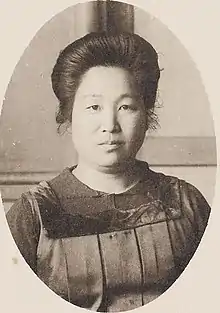Nikaidō Tokuyo | |
|---|---|
 | |
| Born | 二階堂トクヨ December 5, 1880 Miyagi prefecture |
| Died | July 17, 1941 |
Nikaidō Tokuyo (二階堂トクヨ, December 5, 1880 – July 17, 1941) was a Japanese educator, founder of the Japan Women's College of Physical Education. She introduced western competitive team sports, including hockey and cricket, to Japanese women's colleges.
Early life
Nikaidō Tokuyo was born in Miyagi prefecture. She was educated in Matsuyama and Osaka. She held a beginner teacher's license at age 15. She attended Fukushima Normal School for teacher training, but had to change her name temporarily, and become the adopted daughter of a Fukushima resident to qualify. She graduated from normal school in 1899. She pursued further studies at Woman's Higher Normal School.[1]
Career
When Nikaidō was assigned to teach gymnastics at Ishikawa Prefectural High School for Girls, she felt unprepared for the subject. She was granted a scholarship to go to England and study women's physical education programs. She spent three years in England, working with Martina Bergman-Österberg at her training college at Kingsfield House in Kent.[2] She returned to Japan in 1915, ready to start her own training school for physical educators.[1]
Nikaidō opened the Nikaidō Taiso Juku in Tokyo in 1922. She and Inokuchi Akuri both tried to develop practical clothing for women's exercise and sports programs at their schools, Nikaidō favoring tunics similar to what she saw in England, and Inokuchi favoring the middy blouse and short skirts she saw in the United States.[3] One of Nikaidō Taiso Juku's first students, track athlete Hitomi Kinue, became the first Japanese woman to win an Olympic medal, and returned to the school as an instructor.[4] Nikaidō's school later became the Japan Women's College of Physical Education.[5]
Nikaido was also vice-chair of the Federation for Japanese Women's Sports.[6]
Personal life
Nikaido converted to Christianity in adulthood.[6] She died in 1941, aged 60 years. The Japan Women's College of Physical Education continues to train physical educators in Tokyo.[5]
References
- 1 2 Kietlinski, Robin (2011-01-01). Japanese Women and Sport: Beyond Baseball and Sumo. A&C Black. pp. 45–48. ISBN 978-1-84966-340-3.
- ↑ Moon, Rosemary (2011-05-11). "Bergman Österberg Union Archive: Japanese Visitors". Bergman Österberg Union Archive. Retrieved 2020-11-23.
- ↑ Hargreaves, Jennifer; Anderson, Eric (2014-03-05). Routledge Handbook of Sport, Gender and Sexuality. Routledge. pp. 98–99. ISBN 978-1-136-32696-7.
- ↑ Frost, Dennis J. (2010). Seeing Stars: Sports Celebrity, Identity, and Body Culture in Modern Japan. Harvard University Press. pp. 120–121. ISBN 978-0-674-05610-7.
- 1 2 "History of Japan Women's College of Physical Education (JWCPE)". Japan Women's College of Physical Education (JWCPE). Retrieved 2020-11-22.
- 1 2 Kawai, Michi (1934). Japanese Women Speak. By The Central Committee On The United Study Of Foreign Missions. pp. 73–74 – via Internet Archive.